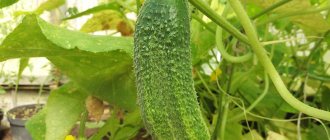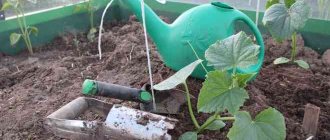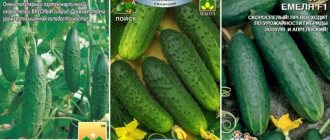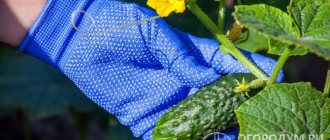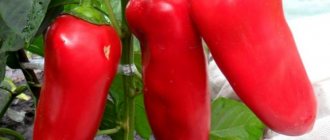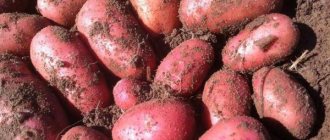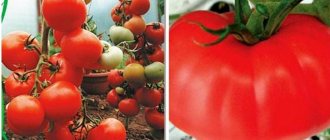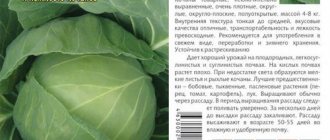Ecole is a relatively new variety of cucumber, suitable for cultivation indoors and outdoors, both in spring-summer and summer-autumn. The first harvest of tuberous cylindrical fruits with a small seed chamber can be harvested 42-45 days after emergence. Greens are great for fresh consumption, canning and pickling.
Cucumbers Ecole
Ecole cucumbers
Ecole cucumbers are suitable for pickling
Description of the variety
Hybrid Ecole F1 was bred by Dutch breeders of the seed company Syngenta Seeds BV. The sample was tested in 2001. The variety was included in the State Register of Breeding Achievements of the Russian Federation in 2007 and is intended for cultivation in the North Caucasus region, which includes:
- Adygea;
- Dagestan;
- Chechen Republic;
- North Ossetia Alania;
- Ingushetia;
- Kabardino-Balkaria;
- Rostov region;
- Stavropol and Krasnodar regions.
We will consider separately how the hybrid grows and bears fruit.
Bushes
The plant has the following characteristics:
- parthenocarpic (self-pollinating), therefore does not require pollination by bees;
- tall - reaches a height of 2.5-3 m;
- medium-climbing with dark green leaves of medium and small size;
- bunch (bouquet) type of flowering - ovaries are formed quickly and intensively, 5 pieces in an axillary bud;
- indeterminate (the main stem grows without restrictions);
- compact with short internodes and additional shoots of 2 leaves (generative type).
With sufficient nutrition, from 5 to 7 cucumbers can be tied in each knot.
Fruit
Ecole bears fruit with greens with the following characteristics:
- type – pickles, gherkins;
- weight - on average 60-75 g (the largest specimens can reach 95-100 g);
- shape – cylindrical;
- length – from 6 to 10 cm, with a ratio to width of 3:1;
- the skin is of high density, bright green in color with whitish stripes and mild spotting, a coarsely tuberous surface and frequent white spines (this type of skin is called “Dutch shirt”);
- the pulp is juicy and crisp with an excellent refreshing taste, genetically free of bitterness and voids, with a dense structure and a small seed chamber.
The Ecole hybrid is often grown to produce pickles, since even small fruits 4-6 cm long are fully formed and have excellent marketability and taste.
Characteristics table
The main parameters of the variety can be found below:
| Parameter | Description |
| Growing method | Gherkin seeds are suitable for growing in open ground and in greenhouse conditions. Read about growing cucumbers in a greenhouse here. |
| Ripening period | The variety is early ripening, so it takes about 42-45 days from the appearance of the first shoots to the formation of mature fruits. |
| Productivity | With proper care, 1 sq. m of plot, you can collect 18-20 kg of full-fledged cucumbers or 7-8 kg of pickles. Marketable yield is not lower than 110 t/ha, which is due to small internodes. |
| Harvesting | Fruiting occurs 1.5 months after sowing the seeds, and harvesting can be done from May to the end of September. Fruits should not be allowed to overripe, as in this case they become tough, hard and tasteless. |
| Disease resistance | The hybrid is resistant to major bacterial diseases - powdery mildew, cladosporiosis (brown spot), cucumber mosaic virus. The plant quickly recovers from exposure to stressful conditions. |
| Application | The variety is canned, so it is great for pickling and salting. After heat treatment, the internal structure does not change, voids are not formed, and the flesh remains elastic and crispy. In addition, the fruits can be consumed fresh. |
Main characteristics
The variety is unpretentious and can be grown in different conditions - in greenhouse conditions or in garden beds.
Productivity
This variety is distinguished by excellent productivity - from each square of area you can collect 18-20 kg of ripe greens. And when growing the Ecole F1 hybrid on an industrial scale, up to 270-290 centners of cucumbers are harvested from each hectare.
Gherkins and pickles should be harvested regularly when they reach a size of 5-8 cm, and new ovaries immediately form on the vines.
Application area
The harvested cucumbers can be used to prepare summer salads and snacks, as well as for pickling and pickling. During heat treatment, the pulp of cucumbers of this variety remains dense and no voids appear in it.
Diseases and pests
This hybrid is genetically resistant to most diseases that are typical for other varieties of cucumbers. However, during the rainy season or if the rules for caring for cucumber vines are not followed, various types of rot may appear on them. And with prolonged drought, aphids may appear on the Ecole cucumber.
Cucumber diseases: photos of leaves and what to do
Against white rot, it is necessary to treat the plants with copper sulfate or urea, and the area before planting cucumbers is watered with a weak solution of manganese. Also, at the end of the season, it is necessary to remove all remnants of vegetation from the beds.
Related article:
How to deal with aphids on cucumbers
Downy mildew usually appears on garden foliage. To prevent this disease from affecting the Ecole hybrid, it is necessary not to plant cucumber bushes too close to each other, and water only with warm water.
Seed material and soil should be disinfected with copper sulfate before planting. The bushes are sprayed with Oksikhom or Kurzat solution.
To prevent the bushes of this cucumber from being affected by gray rot, all seed material should be disinfected before planting, the rules of crop rotation should be observed when planting, and greenhouses should be treated with a solution of copper sulfate. All affected parts of the cucumber vines are cut off, and the cut areas are pollinated with wood ash. And the cucumber lashes themselves should be treated with HOM.
To get rid of aphids, you can wash them off with a stream of running water or soapy water. If the aphid colony is too large, then you can use Aktara or Fitoverm.
Related article:
"Ambulance" for cucumbers: prevention and treatment of diseases
Agricultural technology
In order for the Ecole F1 cucumber to grow and develop well in a personal plot, first of all, you need to take into account the following agrotechnical rules:
- In the middle zone, the crop can be grown through direct sowing of seeds in open ground. In other regions, it is better to use the seedling method, since in this case the plant begins to bear fruit faster and bears fruit more abundantly. The best time for sowing is the second ten days of May.
- For cucumbers, you should choose medium loamy soils that are sufficiently loose. If the soil is heavy, it should be fed with moistened sawdust in the fall.
- Sowing seeds can be done in an area where vegetables such as cabbage grew in the previous season;
- potato;
- onion;
- legumes;
- pepper.
The parthenocarpic hybrid produces equally good yields in both the first and second rotations, therefore it is one of the best options for growing in spring or summer.
Resistance to diseases and pests
Although hybrids of this type are characterized by increased immunity, there are diseases that are dangerous for them :
- powdery mildew usually affects cucumbers in cloudy weather; it can be seen by a white coating on the leaves;
- downy mildew also occurs in conditions of high humidity and is characterized by brown spots on the leaves;
- white and gray rot is manifested by a corresponding coating.
At the initial stage of diseases, it is enough to treat the plants with a solution of potassium permanganate and sprinkle the leaves with ash. At a later stage, fungicides are used, completely affected leaves are removed and burned.
Pests also bother the hybrid:
- aphids suck the juices from the leaves, they are repelled by “Karbofos” (use a small amount of the product);
- spider mites are destroyed with the drug "Vertimek" or infusion of potato tops;
- To remove whiteflies, it is recommended to carefully wash the leaves with soap and water.
The main preventive measure against these pests and diseases is regular loosening and timely watering with inspection of seedlings.
Soil preparation
The soil in the garden or greenhouse must be prepared in advance for planting cucumbers. To do this you need to take the following steps:
- In the fall, remove all tops and weeds from the garden bed, and in greenhouse conditions it is advisable to completely remove the top layer of soil. Dig up the soil using a spade and add organic fertilizer.
- 21 days before planting, warm the soil and destroy pathogenic microflora by adding horse manure. An alternative option is bird droppings, but this must be applied 14 days before planting. If organic matter is added immediately before planting, this will lead to burning of the seeds or roots of the seedlings.
- Immediately before planting, dig up the soil again, apply fertilizer and water with warm water.
Before planting, the soil should be moist and well fertilized so that the sprouts can quickly adapt to new germination conditions.
Reviews from gardeners
Alexandra, 40 years old, Moscow region
I have been growing this variety of cucumbers for several years. I really like the fact that Ekol begins to bear fruit quickly and can be harvested throughout the summer. My family has enough harvest from this variety not only for food, but also for spinning for the winter. Ripe gherkins are tasty and crispy.
Tatyana, 50 years old, Samara region
I grow cucumber Ecole on my plot in a greenhouse. I can say that these vegetables did not suffer from any disease, they bore fruit well, and they tasted better than Satina, for example.
The Dutch cucumber selection Ecole is distinguished by its high yield, resistance to disease and ease of care. That is why it is so popular among vegetable growers from around the world.
Sowing seeds in open ground
The seedless method can be used at the end of spring, when the threat of repeated frosts has completely passed and the soil has warmed up to +15-16°C. In the middle zone, this period falls on May 25-30.
Sowing of sprouted seeds is carried out in the following order:
- In the prepared soil, make shallow holes in advance at intervals of 10-15 cm. The optimal distance between rows is 60-65 cm.
- Moisten the grooves and throw 4-5 seeds into each of them with the expectation that 2-3 plants will remain in the hole. Planting depth – 2-3 cm.
- Cover the crops with film material, which can be removed in a few days.
The first seedlings should be thinned out on the 10th day after planting, leaving up to 10 cm between seedlings. A week later, the seedlings should be thinned out again, increasing the distance between them to 20-25 cm.
Find information on how and when to plant cucumber seedlings in this article.
Productivity
Ecole cucumbers are an indeterminate variety; subject to proper care, the harvest can be harvested from late May to mid-September. Cucumbers are small but numerous. From 1 sq. m you can remove up to 20 kg of crispy and aromatic greens. Due to its high yield, good taste and external qualities, the Ekol variety is suitable for growing not only on a personal plot, but also on an industrial scale.
Ecole cucumbers ripen 40-50 days after seed germination. Harvesting is carried out several times a week, as overripe gherkins lose their aroma and elasticity.
Planting through seedlings
When using the seedling method of growing the Ecole hybrid, it is better to use separate cups with a volume of 0.3-0.5 liters, since the seedlings do not tolerate picking well. You can grow seedlings in separate containers in the following order:
- Pierce the soil mixture of peat, sawdust, leaf humus and fertile soil in the oven or treat it with special means to destroy pest larvae and fungal spores. To skip this step, you can purchase already disinfected substrate at a garden store.
- Fill cups or pots with soil, plant pre-treated seeds to a depth of 2-3 cm and moisten with warm water.
- Place containers in a warm and sunny place. The ideal option is a window sill on the south or west side.
- Before the first shoots appear, cover the crops with film or glass. Next, this covering needs to be removed, and the seedlings should be watered regularly and abundantly with warm water. Of course, the soil should not be allowed to become waterlogged, as this can lead to rotting of the fragile root system.
- In cloudy weather, use a fluorescent lamp to extend daylight hours. Otherwise, the sprouts will stretch and will not produce a good harvest. It is advisable to use additional lighting also in the morning and evening hours.
- For rapid growth, seedlings can be fed with complex fertilizers for vegetable crops without chloride compounds.
- 10-12 days before transplanting into open ground, harden the seedlings by taking them out to the balcony or street for several hours every day.
When the seedlings have 3-4 true leaves, they can be transplanted to a permanent place, since they are able to quickly take root and restore intensive development. At this stage, strong and healthy seedlings should have the following parameters:
- height – no higher than 30 cm;
- leaf color is dark green, without dry spots, tears or wilted areas;
- the roots are strong and intact, entwining the entire earthen lump.
It is no longer worth keeping such seedlings in pots, since at a more mature age it will be more difficult for them to take root in the garden.
The seedlings, together with a lump of earth, must be carefully planted in pre-prepared holes. Seedlings grown in peat pots should be placed directly into the ground, as they will act as additional fertilizer for the roots. The optimal planting density for this hybrid form is 2-3 plants per 1 square meter. m.
Features of growing cucumbers Ekol F1
The productivity of borage is determined not only by the plant variety, but also by weather and climatic conditions, soil composition and moisture.
Choosing a place and neighbors in the garden
This variety produces high yields on loamy, water- and breathable soil with neutral acidity. Plants need to receive a lot of light and heat, so they should be grown in a part of the garden that is warmed by the sun most of the day and protected from the wind.
Experienced gardeners must observe crop rotation and use areas where onions, tomatoes, and carrots grew for planting. But it is better not to plant cucumbers in place of pumpkins, zucchini, squash, melons and watermelons, since these plants are affected by the same diseases. Good companions for cucumbers are sunflowers and greens. It is better to plant potatoes and herbs in another part of the garden. Lowlands with a high level of groundwater should not be allocated for planting - stagnant moisture is detrimental to the crop.
A site for borage is chosen with loose, fertile soil, well heated by the sun.
In the North Caucasus region, where summer temperatures exceed 25 °C (maximum 40 °C), Ecole F1 cucumbers can be cultivated outdoors. In areas with a temperate climate, where nights can be cool and even in early June frosts are common, it is preferable to grow gherkins of this variety under a film cover. Cucumbers require warmth - no lower than 22 °C; cold temperatures down to 5 °C are detrimental to the crop. In protected soil, plants are not subject to sudden changes in night and day temperatures; they are not at risk of spring frosts and cold dew in autumn. In addition, increased air humidity is created under the shelter, which has a beneficial effect on the development of the crop.
Sowing seeds in open ground
Cucumber can be planted on the site when the soil warms up to 15 ° C, approximately in mid-May. Typically, the seeds of this variety are not soaked in stimulant solutions, since they are already treated with the fungicide Thiram. Untreated planting material can be placed in Epin solution for several hours.
Procedure for planting seeds and care:
- In a prepared bed with fertilized soil, mark holes every 10 cm and water them.
- Plant 5 seeds at a depth of 2 cm.
Seeds are sown in a garden bed, several per hole.
- At night or when it gets cold, cover the beds with agrofibre or film.
- After 10 days, the seedlings are thinned out, leaving the strongest plants with an interval of 15 cm between them.
- After the leaves appear, thin out again, the interval between plants is increased to 30 cm.
Video: planting seeds in open ground under a bottle
Growing cucumbers from seedlings
It is preferable to use the seedling method, in which fruiting occurs earlier. Since cucumbers are painful to transplant, it is better to grow them in separate cups.
It is better to sow seeds in peat pots - the plants are planted in the garden along with the container
The procedure for planting seeds to obtain seedlings is as follows:
- Buy a ready-made substrate in advance or prepare it yourself from peat, humus, turf soil and sand in a ratio of 2:2:1:0.5.
- Untreated seeds are soaked in Zircon solution (1 drop/200 ml) and placed in a damp cloth for 2 days.
Soaking seeds in a biostimulant solution accelerates root formation and increases plant resistance to temperature changes
- Plant 2 sprouted seeds in cups to a depth of 2 cm, moisten with warm water.
- Place under film in a warm room with a temperature of 25 °C.
- As soon as the seedling loops appear, the film is removed and the ambient temperature is lowered for 5 days to 19 °C during the day and 15 °C at night.
In the future, the optimal temperature for plants should be maintained - not lower than 15 ° C at night, 22 ° C during the day. The seedlings are watered twice a week with warm water, the optimal temperature is 22–28 °C.
Weak seedlings need to be removed. They are cut, not pulled out, so as not to damage the roots. Leave one strong plant in the pot.
Before planting in the garden, the seedlings must be fed: after the first leaf appears - with liquid mullein (1:10) or chicken droppings (1:20), after 7 days - with a solution of nitrophoska (5 g) and ash (15 g/3 l). When 2–3 true leaves are formed, the seedlings are planted in the ground.
Insufficient nutrition or lack of light, dense planting, and violation of the temperature regime are detrimental to fragile plants - they stretch out and weaken.
The seedling period for cucumbers lasts no more than a month; overexposed plants do not take root well. 3-4 days before planting, they begin to harden off the plants: they are taken out into the garden, covered with agrofibre, first for 4 hours, and then for the whole day.
A month after sowing the seeds, the seedlings are ready for planting in the ground
Planting seedlings in the ground is done as follows:
- The bed is pre-filled with humus (1 bucket/m2).
- The plants are well watered and, together with the moistened soil, taken out of the pots.
- Since the Ecole F1 cucumber has long vines, planting is done in 2 rows according to the 30x60 pattern, deepening the seedlings by 15 cm and placing them in a checkerboard pattern. Plantings should not be thickened; it is recommended to grow no more than 4–5 plants on an area of 1 m2.
- Place the plant in a hole with moistened soil without shaking off the soil from the roots.
- The seedling is sprinkled with soil up to the cotyledon leaves and again watered with 0.5 liters of water.
- At first, the borage must be covered with agrofibre so that it is not damaged by temperature changes or bright sunlight.
Cucumber has been cultivated for more than 6 thousand years; India is considered its homeland. His images are found on the monuments of the ancient Egyptians. This vegetable was the first crop in Russia to be grown in protected soil.
Seedling care
In order for Ecole F1 to bear fruit abundantly, it must be properly cared for, carrying out all agrotechnical measures on time.
Watering and loosening
Watering cucumbers should be abundant and regular, since cucumbers love moisture very much. If there is a shortage of it, the yield of the hybrid will drop, and the taste of the resulting greens will suffer significantly.
You need to water the bushes with warm water in the evening or in the morning every 3-5 days at the rate of 30 liters of water per 1 square meter. m. In hot weather and during fruit set, it is advisable to increase the frequency and intensity of watering. On rainy days, it is worth holding off on moistening the soil.
The best method of watering Ecole is by furrows or sprinkling. Water must be sprayed carefully so that drops do not fall on the leaves, since in sunny weather they can cause burns to the leaf blade. You should also not allow too much water pressure, as it can damage the roots that are close to the surface of the soil.
After each watering or precipitation, it is advisable to loosen the soil between the rows to a depth of no more than 8 cm to improve air exchange. To retain moisture, it is also recommended to mulch the ground with grass or hay.
Top dressing
During the development period, the hybrid needs to be fed several times with organic matter and mineral fertilizers. This should be done on damp soil and in warm weather, when the roots are actively working.
Ecole can be fed with organic fertilizers presented in the table:
| Fertilizer | Preparation and application |
| Horse dung | Dilute organic matter with water in a 1:1 ratio and stir thoroughly so that there are no lumps. Leave for a day, dilute with 5-6 parts of water and use for watering. |
| Mullein | It is prepared in the same way as horse manure, but must be diluted with 4-5 parts of water. Also used for watering. |
| Bird droppings | Unlike previous fertilizers, after infusion for 24 hours, it is diluted with 8-10 parts of water. Used for irrigation. |
| Ash | It is diluted in water at the rate of 100 g per 10 liters and used for watering bushes. |
As for mineral fertilizers, cucumbers should be fed with them 3 times per season. The scheme for their introduction is presented in the table:
| Fertilizer | Deadlines for depositing |
| 10 g of potassium salt, superphosphate and ammonium nitrate per 10 liters of water (per 4 sq. m) | On the 14th day after planting the seedlings in a permanent place. |
| 20 g of potassium salt, superphosphate and ammonium nitrate per 10 liters of water (per 4 sq. m) | 2 weeks after the first feeding. |
| 30 g of potassium sulfate per 10 liters of water (per 4 sq. m) | During the fruiting period (can be applied daily) |
Read about how to properly feed cucumbers in open ground in the following article.
Tying to a support
The bushes of the plant must be tied to a support so that they grow vertically without falling to the ground from the weight of the green mass and many fruits. If the plant is left unsupported, the vines will drag along the ground, which can lead to various plant diseases. If the garter is properly tied, it will be possible to raise the plant towards the sun and create favorable conditions for fruit set.
When tying to a support, the stem of the plant must be twisted twice near the support, and then released down, let in 3 leaves and pinch the growing point.
Formation of bushes
Hybrid Ecole is characterized by medium branching of lateral shoots. When 6-7 leaves are formed, the main stem needs to be pinched, which is necessary for the growth of greens and increasing the yield of the vegetable crop. So, you need to leave 1-2 strong stems, and cut off the remaining shoots.
In order for the bushes to form a strong root system, it is necessary to blind the ovaries in the internodes of the lower 6 leaves. In this case, you can leave 2-3 leaf blades below the ovary. In case of weak development of the bush, it is also advisable to remove the buds from the next tier.
How correctly formed bushes bear fruit can be clearly seen in the video:
Protection from diseases and pests
With the appearance of 3 leaves and before the start of mass fruiting, for preventive purposes, the plant should be sprayed twice with Quadris-250 SC fungicide, using a solution with a concentration of 0.05%. During the same period, preventive spraying of bushes with a 0.02% solution of the drug Farmayod gives good results. Carry out similar treatments in the evening so that the leaves do not suffer from sunburn.
Even with proper care, in conditions of prolonged bad weather the plant may still get sick. The following diseases pose a great danger to cucumbers:
- Powdery mildew . The plant is attacked in cloudy and damp weather. The disease can be identified by a white coating on the leaves and dried leaf blades. The fungicide Tiovit Jet has proven itself well in the fight against powdery mildew.
- Downy mildew . The reason for its appearance is cold weather and excessive humidity. It appears as yellowish-brown oily spots on the surface of the leaves, which are also covered with a gray coating underneath. In case of peronosporosis, the cucumber must be treated with chemicals, among which Ridomil Gold and Topaz are popular among gardeners.
- White rot . If an excessive amount of moisture accumulates on the shoots, this leads to the development of white rot, which is indicated by a white coating on the stems and green shoots. All affected parts of the plant must be removed, and the wound must be treated with a dark pink solution of potassium permanganate and sprinkled with wood ash.
- Gray rot . It also develops in cool and rainy weather. In this case, all parts of the plant are covered with a loose gray coating. They need to be treated with the fungicide Switch 62.5 WG.
- Cucumber mosaic . This is a virus that is carried by infected seeds. It manifests itself as a change in the shape of the leaves and spots on the plant. Sick specimens must be removed from the garden and destroyed, since the disease cannot be treated.
The following pests also pose a certain danger to the Ecole hybrid:
- Aphid . It sucks the life juices out of the leaves, so they wrinkle, curl into tubes and dry out. To destroy aphids, the plant must be treated with chemicals such as Karbofos and Fitoverm.
- Spider mite . When attacked by pests, the leaves become covered with light dots, which gradually turn yellow. A cobweb also appears on the underside of the tops. To destroy the mite, the plant must be treated with Vertimek. For the same purposes, you can use a hot infusion of potato tops. To prepare it, you need to mix 1 kg of tops and 10 g of red pepper, add 10 liters of water and leave for 4 hours. Spray the affected bushes with the product.
- Whitefly . It affects the leaf blade, which darkens and dries over time. To get rid of the pest, the leaves need to be washed with clean water.
To protect a cucumber from pest invasion, you need to regularly loosen and weed the soil, follow the watering schedule and destroy all dry plant debris immediately after harvesting the last harvest.
Read more about diseases, pests of cucumbers and methods of combating them in the following article.
Protection from diseases
The variety is genetically resistant to diseases. However, in rainy summers or with improper care, the risk of rot infection increases. During drought, entire colonies of aphids settle on the shoots. Therefore, preventive measures are necessary.
Table: cucumber diseases and their treatment
| Diseases | Symptoms | Prevention | Measures |
| White rot | The active spread of disease pathogens can be caused by increased soil moisture during a sharp cold snap. The stems are covered with a whitish coating and mucus. The fruits rot. |
|
|
| Downy mildew | It mainly affects foliage. Light yellow spots form on the outer surface of the leaf, the affected buds and flowers turn black, the foliage falls off, and the plant withers. The spread of peronosporosis slows down in heat and drought. |
|
|
| Gray rot | Light brown blurry spots appear on the leaves and stems, the fruits become soft and watery, with gray fluff. |
|
|
Photo gallery: cucumber diseases
White rot affects cucumbers as a result of waterlogging
With downy mildew, light yellow spots appear on the leaves.
Cold weather and prolonged rains lead to the appearance of gray rot
Table: pests of cucumbers and their control
| Pests | Manifestations | Preventive measures | How to help |
| Whitefly | The insect feeds on plant sap, secreting a sticky black coating. The leaves are withering. Parasites lead to slower growth of cucumbers and reduced yield. Warm weather promotes the rapid development of insects. |
|
|
| Aphid | Colonies of aphids, settling on leaves and shoots, suck the juices out of them, which greatly weakens the plant. |
|
|
| Spider mite | Spider mites settle on the underside of the leaf, entangling it with cobwebs. The top of the leaf plate becomes covered with spots. The foliage is withering. The pest appears and actively reproduces only in conditions favorable to it - at high temperatures and dry air. |
|
|
Photo gallery: cucumber pests
A whitefly butterfly lays eggs on the underside of a leaf
The first colonies of aphids appear on the reverse side of the leaves, where the pest rapidly increases its numbers
The spider mite, having settled on the underside of the leaf, entangles it in a web
Harvest and storage
The Ecole cucumber is one of the few vegetables that is beautiful when unripe, which is why it is harvested that way. Overgrown fruits are suitable mainly for harvesting seeds, since they lose their taste and commercial quality and become like barrels.
The gherkins and pickles of the hybrid must be removed every day in the morning or evening. The stems do not need to be twisted, as this can easily damage the lashes. It is better to cut cucumbers with a knife or pruning shears. If there are yellowed shoots or rotten leaves, these must also be carefully removed.
The collected fruits can be stored for several days in a cool place, after discarding limp and yellowed specimens, since they are not suitable for consumption. Healthy cucumbers can be eaten fresh or used for preservation, given the fact that Ekol F1 pickled and pickled cucumbers are not hollow.
Advantages
The main positive qualities of the Ecole F1 include:
- The bushes of this cucumber bear fruit for a long time - from the second ten days of June to the second ten days of September, or even later;
- this hybrid is unpretentious and can be grown both in garden beds and in greenhouse conditions;
- collected gherkins and pickles are devoid of bitterness, so their taste is not affected by unfavorable weather conditions, lack of regular watering and excess light;
- the variety is characterized by increased resistance to diseases such as olive spot, viral cucumber mosaic, powdery mildew;
- the yield of Ekol F1 cucumber is much higher than that of other similar hybrids;
- The hybrid is self-pollinating, so it grows and bears fruit well in greenhouses and film greenhouses.
Advantages and disadvantages
Gardeners have admired the Ecole cucumber due to its following advantages:
- has a stable and high yield (110 t/ha);
- characterized by intensive fruit set (forms up to 9 ovaries from each fruiting node);
- can form fruit ovaries without pollination;
- is highly resistant to tobacco mosaic virus and powdery mildew;
- the fruits are distinguished by their high marketability (the ratio of the length and width of the gherkin is 3:1);
- produces excellent pickles, sweet in taste and without bitterness.
The disadvantages of the hybrid include:
- the presence of prickly thorns on the fruits;
- loss of taste and excessive thickening of fruits when harvested at the wrong time;
- lack of tolerance to downy mildew (downy mildew).
Hydride Ecole F1 is the latest parthenocarpic cucumber of Dutch selection with a mid-early ripening period, which shows excellent survival rate and adaptation to cultivation in the conditions of central Russia. The variety is considered undemanding to care, but to get a good harvest it is important to adhere to all the rules of agricultural technology.
3
0
Copy link
Advantages and disadvantages of the variety
The obvious advantages of the variety include the following qualities::
- high productivity;
- long fruiting period;
- resistance to many diseases;
- lack of bitterness even with rare watering;
- self-pollinating.
There are also disadvantages:
- overripe fruits have a hard skin;
- since this is a hybrid and not a variety, you will have to buy seeds every time;
- they have characteristic spikes.
Growing and care
In general, caring for Ekol is simple
It is important to follow several rules. For irrigation use only warm water
To avoid waterlogging, it is better to create a drainage system rather than pouring water directly under the root. For a drainage system, dig a hole between the rows and pour water into it. This way it will be evenly distributed under all the roots.
Excess shoots without flowers, buds and cucumbers are always cut off. This is done so that excess energy does not leave the plants.
It is best to use organic fertilizers for fertilizing. With non-organic ones, some problems may arise - from soil contamination to changes in the taste of the fruit.
Cucumbers in a greenhouse: traditional methods of feeding Cucumbers that are grown in a greenhouse need regular feeding. Not many people know that preparing fertilizing...
The soil should always be loosened. Oxygen saturation is guaranteed to increase productivity. Collect cucumbers every two to three days as they ripen. Avoid overgrowth.
Advice! Tie up cucumbers when the stems reach a height of 50 cm. Under the weight of the fruit, they easily break, which causes the death of the crop and the impossibility of restoration.
Ecole cucumbers are one of the few varieties suitable for relatively long-term storage. Can be stored for up to two months if:
- Ensure complete sealing - no moisture or air gets into the bag.
- Place the cucumbers in a dark place where the sun does not reach.
- Separate cucumbers from other vegetables.
Criteria for selecting quality seeds
You need to choose seeds for planting based on several important points. New varieties and hybrids are created taking into account many factors; each type of vegetable has a list of advantages and inevitable disadvantages. Summer residents should consider the following properties when choosing:
- if you want to prepare seed material yourself in the future, choose a variety, not a hybrid;
- fruiting time - in order to eat cucumbers all season, you need to take into account how long the vegetable will bear fruit;
- resistance against diseases - hybrids in this regard show better properties than varieties;
- method of pollination and place of cultivation - if there is a lack of bees in the area and cultivation under film or in a greenhouse, you need to take self-pollinating species;
- genetically inherent lack of bitterness;
- verified seed manufacturer, certificates, specialized store.
The need for supports and garters
Greenhouse cultivation of the hybrid involves the use of supports that hold the bush in a vertical position, which allows you to maximize the number of plants and obtain high yields of strong and healthy fruits that are not susceptible to diseases that often arise from contact with the soil. In addition, well-attached bushes make caring for them much easier. As supports, experienced gardeners recommend simple garters on cords or a device such as a trellis - a lattice of wooden or plastic slats with different cell sizes (from 20 to 50 cm). Tie up shoots as they grow
Characteristics and distinctive features
Let's look at the characteristics of Ecole cucumbers and start with a detailed description of the variety.
The plant is medium-climbing and tall. Compact due to short internodes. It has few additional shoots, the growth of the main stem is unlimited. The leaves are dark green, medium in size and smaller. Recovers well from stress.
It has a female type of flowering, blooms in bouquets - several fruits are obtained in one node. “Ekol F1” belongs to the group of parthenocarpic, and in simple terms - self-pollinating hybrids of early maturation.
The length of cucumbers reaches 4-10 cm, and their weight is up to 95 g. The fruits are bright green, with blurry light short stripes and a small number of spots. They have a smooth and beautiful cylindrical shape with medium-sized tubercles and high-density white spines. The length and width of the greens have a ratio of 3.2:1.
The peel is thin. The flesh is crispy, tender and aromatic. There are no voids in the middle, the taste is excellent: sweet, without bitterness (genetic feature).
Productivity
In figures, it is equal to at least 12 tons per 1 hectare. Even if we take the result of 293 centners per 1 hectare, this is already 72 centners per 1 hectare more than the yield of the “Aist” variety, for example. Vegetation occurs over 42-48 days. In the first two weeks of fruiting - three samples of fruits. The harvest does not end until early October.
Optimal timing
The end of May is the time to plant seeds for the climate of Ukraine. The required temperature for heating the soil at a depth of 10 cm is +15. +16 °C (otherwise the plant will develop slowly). Another reference point is when the temperature reaches +22 during the day. +24 °C, and at night - 18 °C.
Site preparation
If you plan to grow Ecole F1 cucumbers next year, but the soil is not suitable, autumn is the time to enrich the compacted and heavy soil with sawdust. Immediately before planting the seeds, the soil needs to be dug up and dry manure or compost added.
Feeding
The hybrid is fed several times a season with organic matter and mineral fertilizers.
At the beginning of flowering, add 15 grams of urea solution,
superphosphate and infusion of manure, diluted in water in a ratio of 1:10. The remaining fertilizing is carried out with a solution of infusion of manure or green fertilizer (1/10) every 2-3 weeks.
These are the main stages of growing a crop such as the Ecole f1 cucumber. Reviews from gardeners are unanimous: the plant is very promising and lives up to expectations for high yields. With a little effort, you can surprise your loved ones with delicious, juicy and crispy cucumbers.
